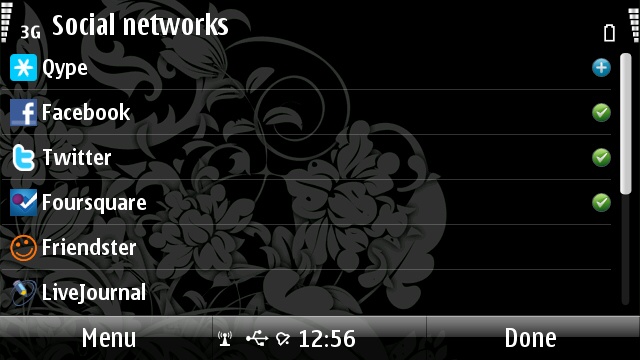And that doesn’t mean just the power users any more – Facebook is now as much a part of life as watching TV, going to the pictures, or having hot dinners. It’s vital that whatever you want to do, your smartphone can do it quickly.
Let’s look at the hot topic in social networking today, location. I’ve written before about the issue of check-in fatigue; where you have to spend time checking in on Foursquare, Facebook, Twitter (via geo-location of the tweets), Qype, Gowalla, and more. It’s just impractical to check in to all of these when you are on the move. One answer is to restrict yourself to one service, the other is to have an application that takes your location just the once, and passes it round all the others in the background.
That’s been one of the advantages of Ovi Maps multi-service check-in system, and for me the addition of Foursquare into the check-in system meant that a solution for me was close at hand. Naturally once I started using it in the real world, away from the clinical office desk of All About Symbian, it proved to be next to useless.

Not because the functionality was missing, but because of the speed of checking in – or lack thereof. With a crowded conference wi-fi network, or a slow 3G network as the alternate, I can only assume the back and forward between the handset, the Ovi servers, and the third party apps was asking too much of the system.
Add to that Ovi Maps needing you in many circumstances to pair up an Ovi location with one in the Foursquare database, to get you to manually confirm the match, and then another long wait while it actually checks in, and I was counting the time to do this ‘simple’ operation in minutes.
Really, it needs to be seconds.
That’s the reason I rapidly switched away from Ovi Maps while in Austin – and while I had concerns about battery consumption, the dedicated Qt Foursquare application proved to be the fastest method of checking in. Yes I went back to the “just use one network” system but to be fair, almost all my peers at SXSW were on Foursquare.
Then there’s Twitter. Nokia’s Social Networking application will get you online and into Twitter (Facebook as well) but exactly the same issue arises here when checking and updating your status. It just takes far too long from making the decision to interact online to actually getting online. It’s one of the reasons that I think power users love Jan Ole Suhr’s Gravity application. It gets you to your information fast.
What worked well for me while I was away were the applications that got on with the job with not only as few clicks as possible, but those that reduced the latency between wanting to do something and finishing the job. That generally involved stripping away as much of the complexity as possible – I wasn’t shocked that a mix of unlimited SMS and the Conversations thread in Nokia’s Messaging application was the best interface for DM and @ messages on Twitter to keep me in touch.
Reducing the time to get to important information has long been a design goal in hardware and software on the smartphone – and with the importance of 'online' now in the mass market, this design goal needs to be promoted. If you’re out there, working on tools and mobile apps that talk to “the social graph” then while your tweaks, filters and whizzy interfaces may look nice, can I just ask you to prioritise one thing over everything else?
Because in the real world, it really is all about the speed.
-- Ewan Spence, March 2011
